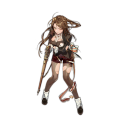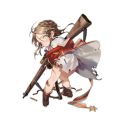Difference between revisions of "Lee-Enfield"
Pootis man (talk | contribs) |
AutumnsFall (talk | contribs) |
||
| Line 7: | Line 7: | ||
|manufactureringame = [[I.O.P.]] | |manufactureringame = [[I.O.P.]] | ||
|manufacturer = | |manufacturer = | ||
| − | Royal Small Arms, The Birmingham Small Arms Company, London Small Arms, Lithgow Small Arms, ROF Fazakerley, ROF Maltby, Savage Arms Company, Long Branch Arsenal, Ishapore Rifle Factory | + | Royal Small Arms Factory Enfield, The Birmingham Small Arms Company, London Small Arms, Lithgow Small Arms, ROF Fazakerley, ROF Maltby, Savage Arms Company, Long Branch Arsenal, Ishapore Rifle Factory |
|artist = {{artist name|rei}} | |artist = {{artist name|rei}} | ||
|fullname = Lee–Enfield | |fullname = Lee–Enfield | ||
| Line 14: | Line 14: | ||
| weaponinfo = | | weaponinfo = | ||
| − | The Lee-Enfield | + | The Lee-Enfield is a bolt-action, magazine-fed, repeating rifle that served as the main firearm used by soldiers of both the British Empire and the British Commonwealth. Rifles in the Lee-Enfield family would serve as the standard infantry rifle of the British army from 1895 to 1957. |
| + | |||
| + | The Lee–Enfield rifle was derived from the earlier Lee–Metford, a mechanically similar black-powder rifle which combined James Paris Lee's rear-locking bolt system with a barrel featuring rifling designed by William Ellis Metford. The Lee action cocked the striker on the closing stroke of the bolt, making the initial opening much faster and easier compared to the "cock on open" design of the Mauser Gewehr 98. The rifle was also equipped with a detachable, 10-round, double-column box magazine, a very modern development in its day. Originally, the concept of a detachable magazine was opposed in some British Army circles, as some feared that the individual soldier might lose the magazine during field campaigns. The Lee–Enfield was adapted to fire the .303 British cartridge, a rimmed, high-powered rifle round. Experiments with smokeless powder in the existing Lee–Metford cartridge seemed at first to be a simple upgrade, but the greater heat and pressure generated by the new smokeless powder wore away the shallow, rounded, Metford rifling after approximately 6000 rounds. Switching to a new square-shaped rifling system designed at the Royal Small Arms Factory (RSAF) Enfield solved the problem, and thus the Lee–Enfield was born.<ref name = "rifleman article">[https://www.americanrifleman.org/articles/2014/7/16/the-lee-enfield-the-greatest-bolt-action-of-the-great-war/#:~:text=Bolt%2DAction%20Historical-,The%20Lee%2DEnfield%3A%20The%20Greatest%20Bolt%2D,Action%20of%20the%20Great%20War&text=In%201888%2C%20the%20British%20combined,Thus%2C%20Lee%2DEnfield. American Rifleman article on the Lee-Enfield]</ref> | ||
| + | |||
| + | The No.1 Mk.III SMLE is perhaps the best known member of the Lee-Enfield family of rifles. The first rifles to be given the SMLE (Short, Magazine, Lee-Enfield) designation arrived in 1904, and featured a number of changes from earlier models. The most substantial changes were the shortening of the barrel and the introduction of a stripper clip guide on the bolt head. It is also here that the Lee-Enfield would gain one of its most defining visual features: its trademark blunt nose cap. These early SMLE rifles are known as 'Mk.I' pattern rifles. Three years after the Mk.I, the SMLE No.1 Mk.III was developed. In comparison to earlier SMLE models, the Mk.III featured a new rear sight and some aesthetic changes to the handguard and magazine. In addition, the stripper clip guide would be moved to a fixed location on the receiver bridge. The chambers were revamped to handle firing the improved Mk VII ammunition, which featured a pointed 'Spitzer' pattern bullet.<ref name = "303 brit ammo article">[https://talesfromthesupplydepot.blog/2017/09/20/mk-vii-303-rounds/ Supply Depot entry on the Mk.VII .303 cartridge]</ref> | ||
| + | |||
| + | The No.1 Mk.III would be the standard infantry rifle of British forces during the First World War. During the war, manufacturers couldn't keep up with the demand for new rifles. In late 1915 the Mk III* was introduced, which incorporated several changes designed to ease manufacturing. The most prominent change was the exclusion of the magazine cutoff system (which when engaged permits the feeding and extraction of single cartridges only while keeping the cartridges in the magazine in reserve). The long-range volley sights present on earlier models of Lee-Enfield rifles were also dropped. The rear sights were simplified, and could no longer be adjusted for windage. Rifles with some or all of these features present are found, as the changes were implemented at different times in different factories and as stocks of parts were depleted.<ref name = "smle youtube video">[https://www.youtube.com/watch?v=hl51NVkt6Sg C&Rsenal video on the SMLE]</ref> | ||
| + | |||
| + | Aside from the legendary Mk.III SMLE, the other most well-known variant of the Lee-Enfield is the No.4 Mk.1 rifle. Developed in the early 1930's, the No.4 was designed to be simpler to mass-produce than previous iterations. It did away with the iconic nose cap of the SMLE, and features a simplified but stronger action. The rear sight was redesigned yet again, and a new spike bayonet was issued instead of a blade bayonet. The No. 4 rifle was also heavier than the No.1 Mk.III, largely due to its heavier barrel. The No.4 Mk.1 would be wielded by British forces during the Second World War.<ref name = "lee-enfield wikipedia article">[https://en.wikipedia.org/wiki/Lee%E2%80%93Enfield Wikipedia article on the Lee-Enfield]</ref> | ||
| + | |||
| + | The Lee-Enfield would see service until 1957, when it was replaced by the L1A1 Self Loading Rifle (the British version of the Belgian-designed FAL rifle. Even after this point, the venerable Lee-Enfield would continue to see limited use as a sniper rifle. The Lee–Enfield family of rifles is the second oldest bolt-action rifle design still in official service, after the Russian-designed Mosin–Nagant. The Canadians didn't begin phasing out the Lee-Enfield until 2016, and it continues to be used by various rebel groups and police forces. | ||
| + | |||
| + | Lee–Enfields are very popular as hunting rifles and target shooting rifles. Many surplus Lee–Enfield rifles were sold in Australia, Canada, New Zealand, South Africa, the United Kingdom, and the United States after the Second World War, and a fair number have been 'sporterised', having had the front furniture reduced or removed and a scope fitted so that they resemble a bolt-action sporting rifle. Many people still hunt with as-issued Lee–Enfield rifles, with commercial .303 British ammunition proving especially effective on medium-sized game. Soft-point .303 ammunition is widely available for hunting purposes, though the Mark 7 military cartridge design often proves adequate because its tail-heavy design makes the bullet yaw violently and deform after hitting the target. | ||
| + | |||
| + | The Lee–Enfield rifle is a popular gun for historic rifle enthusiasts and those who find the 10-round magazine, loading by charger clips, and the smooth bolt-action useful for Practical Rifle events. Since their formation in 1998, organisations such as the Lee-Enfield Rifle Association have assisted in not just preserving rifles in shooting condition (many Lee–Enfields are being deactivated and sold as "wall-hangers" to collectors who do not hold a firearms licence in countries where they are required), but holding events and competitions. Lee–Enfields are also popular with competitors in service rifle competitions in many Commonwealth countries, due to the prohibitions/restrictions on the legal ownership of semi-automatic centerfire rifles in places like Great Britain and Australia. | ||
| design = | | design = | ||
| Line 58: | Line 72: | ||
| trivia = | | trivia = | ||
| − | *In WWI, the term | + | *In WWI, the term 'mad minute' was coined. It referred to a technique for operating the Lee-Enfield that enabled the shooter to perform 15 hits on a 300 yard target in 60 seconds or less. Several First World War accounts tell of British troops repelling German attackers who subsequently reported that they had encountered machine guns, when in fact it was simply a group of well-trained riflemen armed with SMLE Mk.III rifles.<ref>[[wikipedia:Mad_minute|"Mad Minute" Wikipedia entry]]</ref> |
| − | + | *The rifle variant specific to Girls' Frontline is the No.4 Mk.1 (T), the sniper rifle version of the No.4 Mk.1 rifle used in World War 2. The (T) stands for 'Telescope', the term used at the time to refer to a magnified optic. Test batches of No.4 Mk.1 rifles would be fired, and the most accurate of these would be sent to famous British gunsmiths Holland & Holland. There they would receive a scope matched to the rifle by serial number, and a walnut cheek rest on the stock.<ref name = "all about enfields">[http://www.allaboutenfields.co.nz/links-resouces/articles/from-no4mk-i-t-l42-ai All About Enfield article on the No.4 Mk.1 (T)]</ref> | |
| − | *The rifle specific to Girls Frontline is the | + | *The telescopic sight Lee-Enfield uses is the No.32 MK II Scope.<ref name = "scope article">[https://www.gunpartscorp.com/ad/1249080.htm Info page on the Lee-Enfield Scope]</ref> |
| − | </ref> | + | *Much like the M1903 Springfield's Pedersen Device, a prototype version of the Lee-Enfield rifle was built. The rifle was modified with a custom device, allowing the rifle to be shot semi-automatically, and was intended for Canadian Forces during World War II. Russell Turner designed the device, which consisted of a long stroke gas piston, a hammer firing trigger mechanism, and replaced the bolt mechanism with a tilting locking block. The device was rejected and never saw service, due to its mechanical complexity. |
| − | *Much like M1903 Springfield's Pedersen Device, | ||
}} | }} | ||
[[Category:T-Dolls with censoring]] | [[Category:T-Dolls with censoring]] | ||
Revision as of 09:04, 7 September 2020
| Lee-Enfield | Quotes | Live2D |
Lee-Enfield50
    | |
| Gun Information | |
|---|---|
| Full name | Lee–Enfield |
| Country of origin | United Kingdom |
| Manufacturer | Royal Small Arms Factory Enfield, The Birmingham Small Arms Company, London Small Arms, Lithgow Small Arms, ROF Fazakerley, ROF Maltby, Savage Arms Company, Long Branch Arsenal, Ishapore Rifle Factory |
| Game Information | |
| Faction | Griffin & Kryuger |
| Manufactured / Revised by |
I.O.P. |
| Voice actor | Tomatsu Haruka |
| Artist | rei |
| Released on | CN (李-恩菲尔德), TW (李-恩菲爾德), KR (리-엔필드), EN (Lee Enfield), JP (リー・エンフィールド) |
| Chibi Animation | |
| Variant:
Click the marked area to switch between animations. For details regarding animations, please see Animations on the Wiki. | |
Contents
How to obtain
NORMALHEAVY Timer 5:00:00. See T-Doll Production for details.
DROP Not obtainable as a drop.
REWARD Not obtained as a reward
Exclusive Equipment
Union Skill
There is no union skill for this T-Doll.
Stats / Data
Weapon Background
The Lee-Enfield is a bolt-action, magazine-fed, repeating rifle that served as the main firearm used by soldiers of both the British Empire and the British Commonwealth. Rifles in the Lee-Enfield family would serve as the standard infantry rifle of the British army from 1895 to 1957.
The Lee–Enfield rifle was derived from the earlier Lee–Metford, a mechanically similar black-powder rifle which combined James Paris Lee's rear-locking bolt system with a barrel featuring rifling designed by William Ellis Metford. The Lee action cocked the striker on the closing stroke of the bolt, making the initial opening much faster and easier compared to the "cock on open" design of the Mauser Gewehr 98. The rifle was also equipped with a detachable, 10-round, double-column box magazine, a very modern development in its day. Originally, the concept of a detachable magazine was opposed in some British Army circles, as some feared that the individual soldier might lose the magazine during field campaigns. The Lee–Enfield was adapted to fire the .303 British cartridge, a rimmed, high-powered rifle round. Experiments with smokeless powder in the existing Lee–Metford cartridge seemed at first to be a simple upgrade, but the greater heat and pressure generated by the new smokeless powder wore away the shallow, rounded, Metford rifling after approximately 6000 rounds. Switching to a new square-shaped rifling system designed at the Royal Small Arms Factory (RSAF) Enfield solved the problem, and thus the Lee–Enfield was born.[1]
The No.1 Mk.III SMLE is perhaps the best known member of the Lee-Enfield family of rifles. The first rifles to be given the SMLE (Short, Magazine, Lee-Enfield) designation arrived in 1904, and featured a number of changes from earlier models. The most substantial changes were the shortening of the barrel and the introduction of a stripper clip guide on the bolt head. It is also here that the Lee-Enfield would gain one of its most defining visual features: its trademark blunt nose cap. These early SMLE rifles are known as 'Mk.I' pattern rifles. Three years after the Mk.I, the SMLE No.1 Mk.III was developed. In comparison to earlier SMLE models, the Mk.III featured a new rear sight and some aesthetic changes to the handguard and magazine. In addition, the stripper clip guide would be moved to a fixed location on the receiver bridge. The chambers were revamped to handle firing the improved Mk VII ammunition, which featured a pointed 'Spitzer' pattern bullet.[2]
The No.1 Mk.III would be the standard infantry rifle of British forces during the First World War. During the war, manufacturers couldn't keep up with the demand for new rifles. In late 1915 the Mk III* was introduced, which incorporated several changes designed to ease manufacturing. The most prominent change was the exclusion of the magazine cutoff system (which when engaged permits the feeding and extraction of single cartridges only while keeping the cartridges in the magazine in reserve). The long-range volley sights present on earlier models of Lee-Enfield rifles were also dropped. The rear sights were simplified, and could no longer be adjusted for windage. Rifles with some or all of these features present are found, as the changes were implemented at different times in different factories and as stocks of parts were depleted.[3]
Aside from the legendary Mk.III SMLE, the other most well-known variant of the Lee-Enfield is the No.4 Mk.1 rifle. Developed in the early 1930's, the No.4 was designed to be simpler to mass-produce than previous iterations. It did away with the iconic nose cap of the SMLE, and features a simplified but stronger action. The rear sight was redesigned yet again, and a new spike bayonet was issued instead of a blade bayonet. The No. 4 rifle was also heavier than the No.1 Mk.III, largely due to its heavier barrel. The No.4 Mk.1 would be wielded by British forces during the Second World War.[4]
The Lee-Enfield would see service until 1957, when it was replaced by the L1A1 Self Loading Rifle (the British version of the Belgian-designed FAL rifle. Even after this point, the venerable Lee-Enfield would continue to see limited use as a sniper rifle. The Lee–Enfield family of rifles is the second oldest bolt-action rifle design still in official service, after the Russian-designed Mosin–Nagant. The Canadians didn't begin phasing out the Lee-Enfield until 2016, and it continues to be used by various rebel groups and police forces.
Lee–Enfields are very popular as hunting rifles and target shooting rifles. Many surplus Lee–Enfield rifles were sold in Australia, Canada, New Zealand, South Africa, the United Kingdom, and the United States after the Second World War, and a fair number have been 'sporterised', having had the front furniture reduced or removed and a scope fitted so that they resemble a bolt-action sporting rifle. Many people still hunt with as-issued Lee–Enfield rifles, with commercial .303 British ammunition proving especially effective on medium-sized game. Soft-point .303 ammunition is widely available for hunting purposes, though the Mark 7 military cartridge design often proves adequate because its tail-heavy design makes the bullet yaw violently and deform after hitting the target.
The Lee–Enfield rifle is a popular gun for historic rifle enthusiasts and those who find the 10-round magazine, loading by charger clips, and the smooth bolt-action useful for Practical Rifle events. Since their formation in 1998, organisations such as the Lee-Enfield Rifle Association have assisted in not just preserving rifles in shooting condition (many Lee–Enfields are being deactivated and sold as "wall-hangers" to collectors who do not hold a firearms licence in countries where they are required), but holding events and competitions. Lee–Enfields are also popular with competitors in service rifle competitions in many Commonwealth countries, due to the prohibitions/restrictions on the legal ownership of semi-automatic centerfire rifles in places like Great Britain and Australia.
Gallery
Main artwork
Gallery consisting of artworks used primarily in-game. For information on how to obtain certain costumes, see Skin Catalogue.
Alternative artwork
Alternate gallery consisting of artworks with slight alterations as well as miscellaneous artworks.
Trivia
- In WWI, the term 'mad minute' was coined. It referred to a technique for operating the Lee-Enfield that enabled the shooter to perform 15 hits on a 300 yard target in 60 seconds or less. Several First World War accounts tell of British troops repelling German attackers who subsequently reported that they had encountered machine guns, when in fact it was simply a group of well-trained riflemen armed with SMLE Mk.III rifles.[5]
- The rifle variant specific to Girls' Frontline is the No.4 Mk.1 (T), the sniper rifle version of the No.4 Mk.1 rifle used in World War 2. The (T) stands for 'Telescope', the term used at the time to refer to a magnified optic. Test batches of No.4 Mk.1 rifles would be fired, and the most accurate of these would be sent to famous British gunsmiths Holland & Holland. There they would receive a scope matched to the rifle by serial number, and a walnut cheek rest on the stock.[6]
- The telescopic sight Lee-Enfield uses is the No.32 MK II Scope.[7]
- Much like the M1903 Springfield's Pedersen Device, a prototype version of the Lee-Enfield rifle was built. The rifle was modified with a custom device, allowing the rifle to be shot semi-automatically, and was intended for Canadian Forces during World War II. Russell Turner designed the device, which consisted of a long stroke gas piston, a hammer firing trigger mechanism, and replaced the bolt mechanism with a tilting locking block. The device was rejected and never saw service, due to its mechanical complexity.
References
| List of T-Dolls |
|---|















